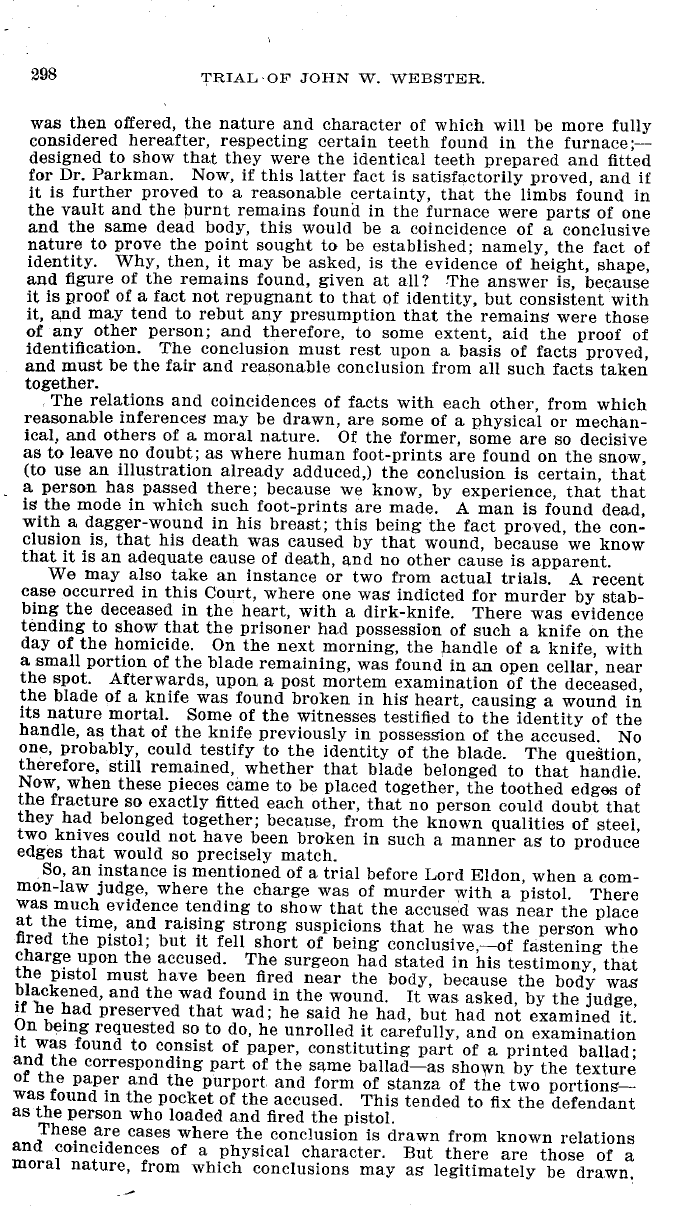|
298 TRIAL OF JOHN W. WEBSTER.
was then offered, the nature and character of which will be more fully
considered hereafter, respecting certain teeth found in the furnace;--
designed to show that they were the identical teeth prepared and fitted
for Dr. Parkman. Now, if this latter fact is satisfactorily proved, and if
it is further proved to a reasonable certainty, that the limbs found in
the vault and the burnt remains found in the furnace were parts of one
and the same dead body, this would be a coincidence of a conclusive
nature to prove the point sought to be established; namely, the fact of
identity. Why, then, it may be asked, is the evidence of height, shape,
and figure of the remains found, given at all? .The answer is, because
it is proof of a fact not repugnant to that of identity, but consistent with
it, and may tend to rebut any presumption that the remains were those
of any other person; and therefore, to some extent, aid the proof of
identification. The conclusion must rest upon a basis of facts proved,
and must be the fair and reasonable conclusion from all such facts taken
together.
The relations and coincidences of facts with each other, from which
reasonable inferences may be drawn, are some of a physical or mechan-
ical, and others of a moral nature. Of the former, some are so decisive
as to leave no doubt; as where human foot-prints are found on the snow,
(to use an illustration already adduced,) the conclusion is certain, that
a person has passed there; because we know, by experience, that that
is the mode in which such foot-prints are made. A man is found dead,
with a dagger-wound in his breast; this being the fact proved, the con-
clusion is, that his death was caused by that wound, because we know
that it is an adequate cause of death, and no other cause is apparent.
We may also take an instance or two from actual trials. A recent
case occurred in this Court, where one was indicted for murder by stab-
bing the deceased in the heart, with a dirk-knife. There was evidence
tending to show that the prisoner had possession of such a knife on the
day of the homicide. On the next morning, the handle of a knife, with
a small portion of the blade remaining, was found in an open cellar, near
the spot. Afterwards, upon a post mortem examination of the deceased,
the blade of a knife was found broken in his heart, causing a wound in
its nature mortal. Some of the witnesses testified to the identity of the
handle, as that of the knife previously in possession of the accused. No
one, probably, could testify to the identity of the blade. The question,
therefore, still remained, whether that blade belonged to that handle.
Now, when these pieces came to be placed together, the toothed edges of
the fracture so exactly fitted each other, that no person could doubt that
they had belonged together because, from the known qualities of steel,
two knives could not have been broken in such a manner as to produce
edges that would so precisely match.
So, an instance is mentioned of a trial before Lord Eldon, when a com-
mon-law judge, where the charge was of murder with a pistol. There
was much evidence tending to show that the accused was near the place
at the time, and raising strong suspicions that he was the person who
fired the pistol; but it fell short of being conclusive,-of fastening the
charge upon the accused. The surgeon had stated in his testimony, that
the pistol must have been fired near the body, because the body was
blackened, and the wad found in the wound. It was asked, by the judge,
if he had preserved that wad; he said he had, but had not examined it.
On being requested so to do, he unrolled it carefully, and on examination
it was found to consist of paper, constituting part of a printed ballad;
and the corresponding part of the same ballad-as shown by the texture
of the paper and the purport. and form of stanza of the two portions-
was found in the pocket of the accused. This tended to fix the defendant
as the person who loaded and fired the pistol.
These are cases where the conclusion is drawn from known relations
and coincidences of a physical character. But there are those of a
moral nature, from which conclusions may as legitimately be drawn,
|

